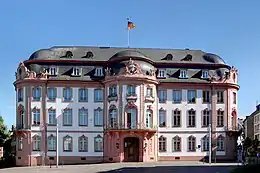Avant-corps
An avant-corps (Italian: avancorpo or risalto, plural risalti, German: Risalit, Polish: ryzalit), a French term literally meaning "fore-body", is a part of a building, such as a porch or pavilion, that juts out from the corps de logis, often taller than other parts of the building.[1][2] It is common in façades in French Baroque architecture.


Particularly in German architecture, a corner Risalit is where two wings meet at right-angles. Baroque three-winged constructions often incorporate a median Risalit in a main hall or a stairwell, such as in Weißenstein Palace and the Roßleben Convent School.
Terms
By position to the building
A central avant-corps stands in the middle of the facade.
A side projection is positioned off-centre.
Two wings (usually) running at right angles to each other flow into a corner avant-corps.
By function
Entrance risalit in which the entrance is located.
Torrisalit, in which a gate or a gate passage is located.
Terms from the environment
The reserve is the facade of the main alignment line of the building, which is receding compared to the front of the risalit. It is also known as Arrierecorps (Arrière-corps, French arrière corps: "behind the structure").
The frontispiece is the gable triangle above a central risalit.[3]
Sources
Much of the text of this article comes from the equivalent German-language Wikipedia article retrieved on 18 March 2006.
- Gérard Fontaine, Charles Garnier's Opéra (Paris, 2000), p. 88.
- Curl, James Stevens (2006). Oxford Dictionary of Architecture and Landscape Architecture, 2nd ed., OUP, Oxford and New York, p. 52. ISBN 978-0-19-860678-9.
- Koch, Wilfried (1994). Baustilkunde das grosse Standardwerk zur europäischen Baukunst von der Antike bis zur Gegenwart (Sonderausg., erw. und völlig neubearb ed.). München. ISBN 978-3-572-00689-2. OCLC 165213550.
{{cite book}}: CS1 maint: location missing publisher (link)